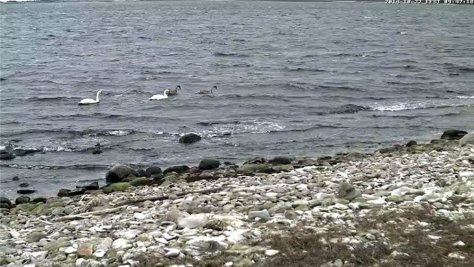VIDEO: Swan family and white-tailed eagles
Video recorded by Aita, LK forum
Translation: Liis
Mute swan Kühmnokk-luik Cygnus olor
The swan family are permanent residents near the web camera. We have already been able to observe their activities for months . Quite a number of white-tailed eagles nest in western Saaremaa and both adult as well as still dark-tailed young birds stray into camera view during the day – on the shore and in shore waters there is always something to be found and so patrol flights must be undertaken daily.
The dark young swans that hatched in the second half of May are 5 months old and quite big compared to the adults. Nature fans know our largest bird, in a sense even a companion to humans, well; they are not confused with the passing migrating whooper swans with their straight necks.
Mute swans were introduced in Europe as late as in the 16th century. Their numbers grew suddenly in the first half of the 20th century. The first known mute swan pair breeding in Estonia was at a South Saaremaa coastal lake in 1908, and the second time was not until after a couple of decades. Breeding swans reached the West Estonian coast during the 60s of the last century and the Gulf of Finland in 1973.
On the coast and the islands mute swans are quite common and nest in increasing numbers – the number of nesters is estimated at more than 3000 pairs. Inland they are still scarce up to now but the population is growing by and by at Peipsi as well as Lake Pihkva. Around 10 000 birds winter, in mild winters of course more.
All swans are protected birds in Estonia. In Great Britain however all the swans even today belong to the Queen …









